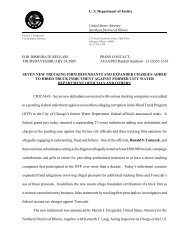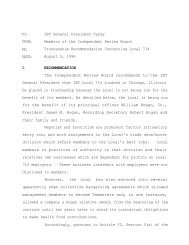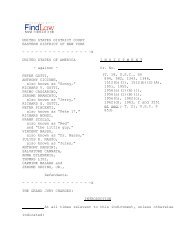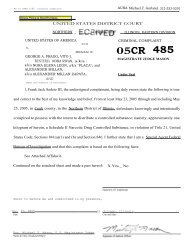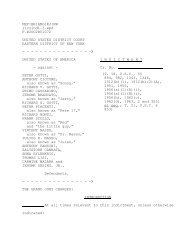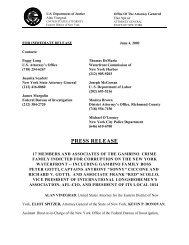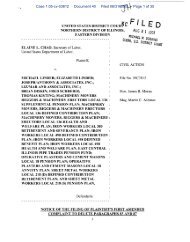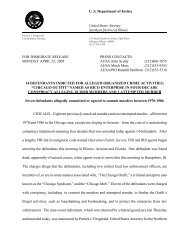Family Secrets Final Indictment - Combined Counties Police ...
Family Secrets Final Indictment - Combined Counties Police ...
Family Secrets Final Indictment - Combined Counties Police ...
Create successful ePaper yourself
Turn your PDF publications into a flip-book with our unique Google optimized e-Paper software.
UNITED STATES DISTRICT COURT<br />
NORTHERN DISTRICT OF ILLINOIS<br />
EASTERN DIVISION<br />
UNITED STATES OF AMERICA )No. 02 CR 1050<br />
)<br />
v. )Violations: Title 18,<br />
)United States Code,<br />
NICHOLAS W. CALABRESE, )Sections 2, 371, 894,<br />
JAMES MARCELLO, )1001(a)(2), 1510, 1951, 1955,<br />
JOSEPH LOMBARDO,<br />
)and 1962(d)<br />
also known as “The Clown,” )<br />
“Lumpy,” and “Lumbo,” )<br />
FRANK CALABRESE, SR., )<br />
FRANK SCHWEIHS, also known as )<br />
“The German,”<br />
)First Superseding <strong>Indictment</strong><br />
FRANK SALADINO, also known as )<br />
“Gumba,” )<br />
PAUL SCHIRO, also known as<br />
“The Indian,”<br />
)<br />
)<br />
MICHAEL MARCELLO, also known as )<br />
“Mickey,” )<br />
NICHOLAS FERRIOLA, )<br />
ANTHONY DOYLE, also known as )<br />
“Twan,” )<br />
MICHAEL RICCI, )<br />
THOMAS JOHNSON, )<br />
JOSEPH VENEZIA, and )<br />
DENNIS JOHNSON )<br />
COUNT ONE<br />
The SPECIAL AUGUST 2003-2 GRAND JURY charges:<br />
I. THE ENTERPRISE<br />
1. At times material to this indictment there existed a<br />
criminal organization which is referred to hereafter as “the<br />
Chicago Outfit." The Chicago Outfit was known to its members and<br />
associates as "the Outfit" and was also known to the public as<br />
“organized crime,” the “Chicago Syndicate” and the “Chicago Mob.”<br />
The Chicago Outfit was an "enterprise" as that term is used in<br />
Title 18, United States Code, Section 1961(4), that is, it<br />
1
constituted a group of individuals associated in fact, which<br />
enterprise was engaged in and the activities of which affected<br />
interstate commerce. The enterprise constituted an ongoing<br />
organization whose members functioned as a continuing unit for a<br />
common purpose of achieving the objectives of the enterprise.<br />
2. The Chicago Outfit existed to generate income for its<br />
members and associates through illegal activities. The illegal<br />
activities of the Chicago Outfit included, but were not limited to:<br />
(1) collecting “street tax,” that is, extortion payments required<br />
as the cost of operating various businesses;(2) the operation of<br />
illegal gambling businesses, which included sports bookmaking and<br />
the use of video gambling machines; (3) making loans to individuals<br />
at usurious rates of interest (hereafter referred to as "juice<br />
loans”), which loans constituted "extortionate extensions of<br />
credit," as that term is defined in Title 18, United States Code,<br />
Section 891(6); (4) "collecting" through "extortionate means" juice<br />
loans constituting "extensions of credit," as those terms are<br />
defined in Title 18, United States Code, Sections 891(5), (7) and<br />
(6), respectively; (5) collecting debts incurred in the Chicago<br />
Outfit's illegal gambling businesses; (6) collecting debts incurred<br />
in the Chicago Outfit's juice loan business, which debts carried<br />
rates of interest at least twice the rate enforceable under<br />
Illinois law; (7) using threats, violence and intimidation to<br />
collect street tax and juice loan debts; (8) using threats,<br />
violence, and intimidation to discipline Chicago Outfit members and<br />
associates; (9) using murder of Chicago Outfit members, associates<br />
2
and others to advance the interests of the Chicago Outfit’s illegal<br />
activities; (10) obstructing justice and criminal investigations by<br />
intimidating, bribing, retaliating against, and murdering witnesses<br />
and potential witnesses who could provide information adverse to<br />
the enterprise’s interests; and (11) traveling in interstate<br />
commerce to further the goals of the criminal enterprise.<br />
3. In order to carry out its criminal activities, the<br />
Chicago Outfit maintained a structure and chain of command. The<br />
criminal activities of the Chicago Outfit were carried out in part<br />
by sub-groups, or “crews,” which were generally given territories<br />
in different geographic locations in the Chicago area. These crews<br />
were known by their geographic areas, and included the Elmwood Park<br />
crew, the North Side/Rush Street crew, the South Side/26th Street<br />
or Chinatown crew, the Grand Avenue crew, the Melrose Park crew,<br />
and the Chicago Heights crew. Each crew was run by a crew leader,<br />
also known as a street boss or “capo,” and these crew bosses<br />
reported to an underboss, or “sotto capo,” who was second in<br />
command of the Chicago Outfit, and therefore referred to at times<br />
as “Number Two.”<br />
The overall leader of the Chicago Outfit was<br />
referred to as the Boss or “Number One.” The Chicago Outfit also<br />
utilized a “consigliere,” who provided advice to the Boss.<br />
4. When an individual conducting illegal activities on behalf<br />
of the Chicago Outfit proved himself particularly trustworthy and<br />
was to be given special status in the enterprise, he was given<br />
“made” status. An individual could not normally be “made” unless<br />
he was of Italian descent, and had committed at least one murder on<br />
3
ehalf of the enterprise. An individual had to be sponsored by his<br />
capo before he could be “made,” which occurred at a ceremony in<br />
which the person to be “made” swore allegiance to the enterprise.<br />
This ceremony was attended by the individual’s capo, as well as<br />
other ranking members of the Chicago Outfit.<br />
Once “made,” the<br />
individual was accorded greater status and respect in the<br />
enterprise. An individual who was “made” or who committed a murder<br />
on behalf of the Outfit was obligated to the enterprise for life to<br />
perform criminal acts on behalf of the enterprise when called upon.<br />
5. Disputes between members of different crews were to be<br />
resolved first by their respective capos, and, if no resolution<br />
could be made between the capos, then the Boss would settle the<br />
dispute.<br />
6. During the course of the conspiracy, Anthony Accardo, also<br />
known as “Big Tuna,” and “Joe Batters,” Joseph Aiuppa, also known<br />
as “Doves,” and “Joey O’Brien,” Sam Carlisi, also known as “Wings,”<br />
and John Monteleone, also known as “Johnny Apes,” among others,<br />
acted as Boss of the Chicago Outfit.<br />
7. During the course of the conspiracy, Joseph Aiuppa, and<br />
Jack Cerone, among others, acted as Sotto Capo, or Underboss, of<br />
the Chicago Outfit.<br />
8. During the course of the conspiracy, Joseph Ferriola was<br />
a “made” member of the Chicago Outfit who reported directly to the<br />
Boss. Harry Aleman, William Petrocelli, also known as “Butch,”<br />
Jerry Scarpelli, and others, were criminal associates who reported<br />
at various times to Joseph Ferriola.<br />
4
9. Defendant JAMES MARCELLO was a member of the Melrose Park<br />
crew, was a “made” member of the Chicago Outfit, and committed<br />
murder and other criminal activities on its behalf.<br />
Defendant<br />
JAMES MARCELLO continued to conduct criminal activities on the<br />
Outfit’s behalf while incarcerated through his brother, defendant<br />
MICHAEL MARCELLO, and others.<br />
10. Defendant JOSEPH LOMBARDO, also known as “the Clown,”<br />
“Lumpy,” and “Lumbo,” was a member of the Grand Avenue crew, and<br />
committed murder and other criminal activities on its behalf.<br />
11. Defendant FRANK CALABRESE, SR., was a member of the South<br />
Side/26th Street crew, was a “made” member of the Chicago Outfit,<br />
and committed murder and other criminal activities on its behalf.<br />
Defendant FRANK CALABRESE, SR., continued to conduct criminal<br />
activities on the Outfit’s behalf while incarcerated through<br />
defendants FERRIOLA, DOYLE, RICCI, and others.<br />
12. Other members of the South Side/26 th Street crew were<br />
James Torello, also known as “Turk,” Angelo LaPietra, also known as<br />
“the Hook,” and “the Bull,” and James LaPietra, all of whom served<br />
as capos of this crew during the course of the conspiracy.<br />
Additional members of this crew included John Monteleone, John<br />
Fecarotta, Ronald Jarrett, James DiForti, Frank Furio, and Frank<br />
Santucci.<br />
13. Defendant NICHOLAS CALABRESE is the brother of defendant<br />
FRANK CALABRESE, SR., was also a member of the South Side/26 th<br />
Street crew, was a “made” member of the Chicago Outfit, and<br />
committed murder and other criminal activities on its behalf.<br />
5
14. Defendant FRANK SCHWEIHS, also known as “the German,” was<br />
an enforcer for the Chicago Outfit, imposing and collecting “street<br />
tax” for himself and Outfit members, and making additional<br />
collections on behalf of the enterprise through the use of<br />
extortionate means.<br />
Defendant SCHWEIHS also agreed to commit<br />
murder on behalf of the Chicago Outfit.<br />
15. Defendant FRANK SALADINO, also known as “Gumba,” was a<br />
member of the South Side/26 th Street crew, and committed murder and<br />
other criminal activities on behalf of the Chicago Outfit.<br />
16. Defendant PAUL SCHIRO, also known as “the Indian,” was a<br />
criminal associate of defendant SCHWEIHS, “made” member Anthony<br />
Spilotro, and Outfit associate Joseph Hansen, who committed murder<br />
and other criminal activities on behalf of the Chicago Outfit.<br />
17. Defendant MICHAEL MARCELLO, also known as “Mickey,” is<br />
the brother of defendant JAMES MARCELLO, and was a member of the<br />
Melrose Park crew. Defendant MICHAEL MARCELLO assisted his<br />
brother’s participation in the activities of the enterprise while<br />
defendant JAMES MARCELLO was in jail, by keeping his brother<br />
informed of the enterprises’s activities, delivering messages to<br />
persons associated with the enterprise, and carrying out illegal<br />
activities of the Chicago Outfit, including the operation of an<br />
illegal video gambling business.<br />
18. Defendant NICHOLAS FERRIOLA is the son of Joseph<br />
Ferriola, and was a member of the South Side/26 th Street crew who<br />
assisted defendant FRANK CALABRESE, SR.’s participation in the<br />
activities of the enterprise while defendant FRANK CALABRESE, SR.,<br />
6
was in jail, by keeping defendant FRANK CALABRESE, SR., informed of<br />
the enterprise’s activities, delivering messages to persons<br />
associated with the enterprise, collecting monies generated by<br />
extortionate demands of defendant FRANK CALABRESE, SR., and<br />
carrying out other illegal activities of the Chicago Outfit,<br />
including the operation of an illegal sports bookmaking business.<br />
19. Defendant ANTHONY DOYLE, also known as “Twan,” is a<br />
retired Chicago <strong>Police</strong> Department (“CPD”) officer, who, at the time<br />
he was employed as a CPD officer, assisted defendant FRANK<br />
CALABRESE, SR.’s participation in the activities of the enterprise<br />
while defendant FRANK CALABRESE, SR., was in jail, by keeping<br />
defendant FRANK CALABRESE, SR. informed of a law enforcement<br />
investigation into the murder of John Fecarotta, committed by<br />
defendants FRANK CALABRESE, SR., NICHOLAS CALABRESE, and others.<br />
Defendant DOYLE also agreed to pass messages from defendant FRANK<br />
CALABRESE, SR., in jail to other members of the Chicago Outfit,<br />
including messages designed to determine whether defendant NICHOLAS<br />
CALABRESE or James DiForti, now deceased, was cooperating with law<br />
enforcement about the activities of the enterprise.<br />
20. Defendant MICHAEL RICCI is a retired CPD officer, who at<br />
the time he was subsequently employed with the Cook County<br />
Sheriff’s Department, assisted defendant FRANK CALABRESE, SR.’s<br />
participation in the activities of the enterprise while defendant<br />
FRANK CALABRESE, SR., was in jail, by agreeing to pass messages<br />
from defendant FRANK CALABRESE, SR., to other members of the<br />
Chicago Outfit, including messages designed to determine whether<br />
7
defendant NICHOLAS W. CALABRESE or James DiForti was cooperating<br />
with law enforcement about the activities of the enterprise.<br />
Defendant RICCI also agreed to assist defendant FRANK CALABRESE,<br />
SR., in collecting monies generated by extortionate demands of<br />
defendant FRANK CALABRESE, SR., and to provide materially false<br />
information to special agents of the Federal Bureau of<br />
Investigation.<br />
II. THE RACKETEERING CONSPIRACY<br />
21. From approximately the middle of the 1960s through the<br />
date of the return of this indictment, the exact dates being<br />
unknown to the Grand Jury, in the Northern District of Illinois,<br />
Eastern Division, and elsewhere,<br />
NICHOLAS W. CALABRESE,<br />
JAMES MARCELLO,<br />
JOSEPH LOMBARDO, also known as<br />
“The Clown,” “Lumpy,” and “Lumbo,”<br />
FRANK CALABRESE, SR.,<br />
FRANK SCHWEIHS, also known as<br />
“The German,”<br />
FRANK SALADINO, also known as<br />
“Gumba,”<br />
PAUL SCHIRO, also known as<br />
“The Indian,”<br />
MICHAEL MARCELLO, also known as<br />
“Mickey,”<br />
NICHOLAS FERRIOLA,<br />
ANTHONY DOYLE, also known as<br />
“Twan,” and<br />
MICHAEL RICCI,<br />
defendants herein, being persons employed by and associated with an<br />
enterprise, that is, the Chicago Outfit, which enterprise engaged<br />
in and the activities of which affected, interstate commerce, did<br />
knowingly conspire and agree, with other persons known and unknown<br />
to the Grand Jury, to conduct and to participate, directly and<br />
8
indirectly, in the conduct of the affairs of the Chicago Outfit<br />
through: (1) a "pattern of racketeering activity," as that term is<br />
defined in Title 18, United States Code, Sections 1961(1) and<br />
1961(5), and as further specified in paragraph 49 of this count,<br />
and (2) the "collection of unlawful debt," as that term is defined<br />
in Title 18, United States Code, Section 1961(6), and as further<br />
specified in paragraph 50 of this count, both in violation of Title<br />
18, United States Code, Section 1962(c).<br />
22. It was part of the conspiracy that each defendant agreed<br />
that a conspirator would commit at least two acts of racketeering<br />
in the conduct of the affairs of the enterprise.<br />
23. It was further part of the conspiracy that the<br />
defendants, together with other persons known and unknown to the<br />
Grand Jury, each agreed to conduct and to participate in the<br />
conduct of the Chicago Outfit's affairs through the collection of<br />
unlawful debt.<br />
24. It was further part of the conspiracy that acts of murder<br />
would be attempted and were committed to further the criminal<br />
objectives of the Chicago Outfit and protect the enterprise from<br />
law enforcement. Such murders and attempted murders included:<br />
a. the murder of Michael Albergo, also known as “Hambone,” in<br />
or about August, 1970, in Chicago, Illinois;<br />
b. the murder of Daniel Seifert, on or about September 27,<br />
1974, in Bensenville, Illinois;<br />
c. the murder of Paul Haggerty, on or about June 24, 1976, in<br />
Chicago, Illinois;<br />
d. the murder of Henry Cosentino, on or about March 15, 1977;<br />
9
e. the murder of John Mendell, on or about January 16, 1978,<br />
in Chicago, Illinois;<br />
f. the murders of Donald Renno and Vincent Moretti, on or<br />
about January 31, 1978, in Cicero, Illinois;<br />
g. the murders of William and Charlotte Dauber, on or about<br />
July 2, 1980, in Will County, Illinois;<br />
h. the murder of William Petrocelli, on or about December 30,<br />
1980, in Cicero, Illinois;<br />
i. the murder of Michael Cagnoni, on or about June 24, 1981,<br />
in DuPage County, Illinois;<br />
j. the murder of Nicholas D’Andrea, on or about September 13,<br />
1981, in Chicago Heights, Illinois;<br />
k. the attempted murder of Individual A, on or about April 24,<br />
1982, in Lake County, Illinois;<br />
l. the murders of Richard D. Ortiz and Arthur Morawski, on or<br />
about July 23, 1983, in Cicero, Illinois;<br />
m. the murder of Emil Vaci, on or about June 7, 1986, in<br />
Phoenix, Arizona;<br />
n. the murders of Anthony and Michael Spilotro, on or about<br />
June 14, 1986, in DuPage County, Illinois;<br />
o. the murder of John Fecarotta, on or about September 14,<br />
1986, in Chicago, Illinois.<br />
25. It was further part of the conspiracy that at times<br />
members of one crew would assist members of other crews in<br />
homicides, by conducting surveillances of and luring intended<br />
victims so that the victims would not be alerted that they were<br />
targeted for murder.<br />
26. It was further part of the conspiracy that cash payments<br />
would be and were extorted from numerous individuals as “street<br />
tax” to allow businesses run by those individuals to continue to<br />
operate.<br />
10
27. It was further part of the conspiracy that loans made at<br />
usurious rates, or “juice loans,” would be and were made to<br />
numerous individuals. These loans carried interest rates generally<br />
ranging from one percent (1%) to ten percent (10%) per week, which<br />
translate into annual rates of 52% to 520%, respectively.<br />
In<br />
making these juice loans, the conspirators agreed to rely and did<br />
rely upon the borrower's understanding at the time the loan was<br />
made that delay or failure to repay the loans could result in the<br />
use of violence or other criminal means to cause harm to the<br />
borrower. The conspirators also understood at the time each juice<br />
loan was made that delay or failure to repay the loans could result<br />
in the use of violence or other criminal means to cause harm to the<br />
particular borrower.<br />
28. It was further part of the conspiracy that “juice loan”<br />
payments would be and were collected from numerous juice loan<br />
debtors, who borrowed money from conspirators at the rates<br />
described in the previous paragraph. The conspirators each<br />
understood at the time they collected each juice loan payment that<br />
delay or failure to repay the loan could result in the use of<br />
violence or other criminal means to cause harm to the particular<br />
debtor. The conspirators used violence, intimidation and threats<br />
to collect these debts.<br />
29. It was further part of the conspiracy that collections<br />
would be made of debts incurred in connection with the juice loan<br />
business described in this Count, which business charged rates of<br />
interest at least twice the rate enforceable under Illinois law.<br />
11
30. It was further part of the conspiracy that members and<br />
associates of the Chicago Outfit would and did knowingly conduct,<br />
finance, manage, supervise, direct, and own all or part of illegal<br />
gambling businesses in violation of the laws of the State of<br />
Illinois, including illegal sports bookmaking businesses, and<br />
businesses which utilized video gambling machines for illegal<br />
wagering.<br />
31. It was further part of the conspiracy that members and<br />
associates of the Chicago Outfit agreed to collect and did collect<br />
debts incurred in connection with illegal gambling businesses<br />
described in this Count.<br />
32. It was further part of the conspiracy that members and<br />
associates of the Chicago Outfit used violence, intimidation and<br />
threats to: (1) instill discipline within the Chicago Outfit by<br />
compelling adherence to the Chicago Outfit's edicts and<br />
instructions; and (2) punish conduct by Chicago Outfit members,<br />
associates and others, which the hierarchy of the Chicago Outfit<br />
believed was adverse to the interests of the Chicago Outfit.<br />
33. It was further part of the conspiracy that members and<br />
associates of the Chicago Outfit would and did obstruct the due<br />
administration of justice by: (1) intimidating, harming, and<br />
killing witnesses and potential witnesses who could provide<br />
information detrimental to the operations of the enterprise; (2)<br />
providing false information to law enforcement officers; and (3)<br />
paying money to individuals to keep them from cooperating with law<br />
enforcement officials.<br />
12
34. It was further part of the conspiracy that the<br />
conspirators would and did use nominees, “fronts,” and fictitious<br />
names to hide the proceeds of criminal activities.<br />
35. It was further part of the conspiracy that the<br />
conspirators would and did use coded language in their discussions<br />
and written materials, and utilized coded names for discussing<br />
fellow conspirators and victims of their criminal activities.<br />
36. It was further part of the conspiracy that the<br />
conspirators would and did collect information from corrupt law<br />
enforcement sources to determine and disrupt legitimate law<br />
enforcement investigation into the activities of the enterprise.<br />
37. It was further part of the conspiracy that the<br />
conspirators would and did steal, store, and utilize “work cars”<br />
for use in their criminal activities, including surveillance of<br />
murder victims and committing murders.<br />
38. It was further part of the conspiracy that the<br />
conspirators would and did use walkie-talkies and citizen band<br />
radios to communicate amongst themselves while conducting criminal<br />
activities, including murder.<br />
39. It was further part of the conspiracy that the<br />
conspirators would and did monitor law enforcement radio<br />
frequencies, and acquire radio equipment, monitors, and crystals to<br />
do so, in order to detect and avoid law enforcement inquiry into<br />
their activities, including murder.<br />
40. It was further part of the conspiracy that the<br />
conspirators would and did conduct surveillance to detect the<br />
13
presence of law enforcement while they and coconspirators were<br />
committing illegal activities, including murder.<br />
41. It was further part of the conspiracy that the<br />
conspirators would and did acquire explosives, explosive devices,<br />
detonators, transmitters, and remote control devices with the<br />
intent to murder individuals without needing to be in the immediate<br />
vicinity of the intended victim.<br />
42. It was further part of the conspiracy that the<br />
conspirators would and did acquire and store firearms to be used to<br />
commit murder.<br />
43. It was further part of the conspiracy that the<br />
conspirators would and did use pagers and pay phones in an effort<br />
to reduce law enforcement’s ability to intercept their<br />
communications.<br />
44. It was further part of the conspiracy that the<br />
conspirators would and did maintain hidden interests in businesses,<br />
from which they could receive income not traceable to them.<br />
45. It was further part of the conspiracy that the<br />
conspirators would and did maintain hidden control of labor<br />
organizations and assets.<br />
46. It was further part of the conspiracy that the<br />
conspirators would and did utilize the threat of labor union<br />
violence or disruptions to induce payments to the enterprise to<br />
keep “union peace.”<br />
14
47. It was further part of the conspiracy that the<br />
conspirators would and did maintain written records and ledgers for<br />
their loansharking and bookmaking activities.<br />
48. It was further part of the conspiracy that members and<br />
associates of the Chicago Outfit misrepresented, concealed and hid,<br />
caused to be misrepresented, concealed and hidden, and attempted to<br />
misrepresent, conceal and hide the operation of the Chicago Outfit<br />
and acts done in furtherance of the enterprise.<br />
III. PATTERN OF RACKETEERING ACTIVITY<br />
(First Alternative Ground of Liability)<br />
49. The pattern of racketeering activity through which the<br />
defendants agreed to conduct and to participate in the conduct of<br />
the Chicago Outfit's affairs, consisted of multiple violations of<br />
the following federal and state laws:<br />
(a) Acts and threats involving murder chargeable under<br />
the law of the States of Illinois, Arizona, and Nevada, which are<br />
punishable by imprisonment for more than one year; that is, first<br />
degree murder (Illinois: Illinois Revised Statutes, Chapter 38, §9-<br />
1; Arizona: Arizona Revised Statutes §13-1105), conspiracy to<br />
commit murder (Illinois: Illinois Revised Statutes, Chapter 38, §8-<br />
2; Arizona: Arizona Revised Statutes §13-1003; Nevada: Nevada<br />
Revised Statutes §199.480), and attempted murder (Illinois:<br />
Illinois Revised Statutes, Chapter 38, §8-4);<br />
(b) Making and conspiring to make extortionate extensions<br />
of credit, indictable under Title 18, United States Code, Section<br />
892;<br />
15
(c) Collecting and conspiring to collect extensions of<br />
credit by extortionate means, indictable under Title 18, United<br />
States Code, Section 894;<br />
(d) Interference with commerce by threats and violence,<br />
and conspiring to commit this offense, indictable under Title 18,<br />
United States Code, Section 1951;<br />
(e)<br />
Acts and threats involving extortion in violation of<br />
state law, which are punishable by imprisonment for more than one<br />
year; that is, intimidation, in violation of Chapter 38, Illinois<br />
Revised Statutes, §12-6 (which later became 720 ILCS 5/12-6 of the<br />
Illinois Compiled Statutes) and conspiracy to commit intimidation,<br />
in violation of Chapter 38, Illinois Revised Statutes, §8-2 (which<br />
later became 720 ILCS 5/8-2 of the Illinois Compiled Statutes);<br />
(f)<br />
Operating an illegal gambling business indictable<br />
under Title 18, United States Code, Section 1955;<br />
(g) Obstructing the due administration of justice,<br />
indictable under Title 18, United States Code, Section 1503;<br />
(h) Obstruction of criminal investigations, indictable<br />
under Title 18, United States Code, Section 1510;<br />
(i) Witness tampering, indictable under Title 18, United<br />
States Code, Section 1512;<br />
(j) Retaliating against a witness, indictable under Title<br />
18, United States Code, Section 1513;<br />
(k) Interstate travel in aid of racketeering enterprises,<br />
indictable under Title 18, United States Code, Section 1952.<br />
16
IV. COLLECTION OF UNLAWFUL DEBT<br />
(Second Alternative Ground of Liability)<br />
50. The collection of unlawful debt through which the<br />
defendants agreed to conduct and to participate in the affairs of<br />
the enterprise, consisted of multiple acts of collecting and<br />
attempting to collect debt incurred in connection with the Chicago<br />
Outfit's operation of illegal gambling businesses and its lending<br />
money at usurious rates, which loans were unenforceable under<br />
Illinois laws relating to usury, such gambling and loan debts<br />
constituting unlawful debt as defined in Title 18, United States<br />
Code, Sections 1961(6)(A) and (B).<br />
All of the above in violation of Title 18, United States Code,<br />
Section 1962(d).<br />
17
COUNT TWO<br />
The SPECIAL AUGUST 2003-2 GRAND JURY further charges:<br />
From in or before 1996 and continuing through the date of this<br />
indictment, in the Northern District of Illinois, Eastern Division,<br />
and elsewhere,<br />
JAMES MARCELLO,<br />
MICHAEL MARCELLO, also known as<br />
“Mickey,”<br />
THOMAS JOHNSON,<br />
JOSEPH VENEZIA, and<br />
DENNIS JOHNSON,<br />
defendants herein, together with other persons known and unknown to<br />
the Grand Jury, knowingly conducted all or part of an illegal<br />
gambling business, that is, a business involving the use of video<br />
gambling machines and devices in the western Chicago suburbs and<br />
surrounding areas, which business was in substantially continuous<br />
operation for a period in excess of thirty (30) days, which<br />
involved five or more persons who conducted, financed, managed,<br />
supervised, directed, and owned all or part of the business, and<br />
which was a violation of the following laws of the State of<br />
Illinois: Illinois Revised Statutes, Chapter 38, Sections 8-2, 28-<br />
1(a)(1), (3), and (5) and 28-3, which later became 720 ILCS 5/8-2,<br />
5/28-1(1), (3), and (5), and 5/28-3;<br />
and 2.<br />
In violation of Title 18, United States Code, Sections 1955<br />
18
COUNT THREE<br />
The SPECIAL AUGUST 2003-2 GRAND JURY further charges:<br />
From in or about 1998 and continuing until at least January<br />
2003, in the Northern District of Illinois and elsewhere,<br />
JAMES J. MARCELLO, and<br />
MICHAEL A. MARCELLO, also known as<br />
“Mickey,”<br />
defendants herein, did willfully endeavor by means of bribery to<br />
obstruct, delay, and prevent the communication of information<br />
relating to violations of criminal statutes of the United States by<br />
a person to a criminal investigator; that is, the defendants paid<br />
and caused to be paid a monthly sum of money to and on behalf of<br />
Nicholas W. Calabrese in order to maintain his allegiance to the<br />
Chicago Outfit and to prevent and discourage his cooperation with<br />
law enforcement authorities;<br />
and 2.<br />
In violation of Title 18, United States Code, Sections 1510<br />
19
COUNT FOUR<br />
The SPECIAL AUGUST 2003-2 GRAND JURY further charges:<br />
From sometime in the early 1980s and continuing until<br />
approximately November 2002, in the Northern District of Illinois<br />
and elsewhere,<br />
FRANK CALABRESE, SR., and<br />
NICHOLAS FERRIOLA,<br />
defendants herein, knowingly committed extortion, as that term is<br />
used in Title 18, United States Code, Section 1951(b)(2), which<br />
extortion affected interstate commerce as that term is used in<br />
Title 18, United States Code, Section 1951(b)(3), in that the<br />
defendants would and did obtain money as “street tax” from a<br />
restaurant operating in Chicago, with the consent of a<br />
representative of the restaurant, induced by the wrongful use of<br />
actual and threatened force, violence, and fear;<br />
and 2.<br />
In violation of Title 18, United States Code, Sections 1951<br />
20
COUNT FIVE<br />
The SPECIAL AUGUST 2003-2 GRAND JURY further charges:<br />
From sometime in 1992 and continuing until at least sometime<br />
in 2001, in the Northern District of Illinois and elsewhere,<br />
FRANK CALABRESE, SR., and<br />
NICHOLAS FERRIOLA,<br />
defendants herein, together with other persons known and unknown to<br />
the Grand Jury, knowingly conducted all or part of an illegal<br />
gambling business, that is, a sports bookmaking business, which<br />
business was in substantially continuous operation for a period in<br />
excess of thirty (30) days, which involved five or more persons who<br />
conducted, financed, managed, supervised, directed, and owned all<br />
or part of the business, and which was a violation of the following<br />
laws of the State of Illinois: Illinois Revised Statutes, Chapter<br />
38, Sections 8-2, 28-1(a)(1), (3), and (5) and 28-3, which later<br />
became 720 ILCS 5/8-2, 5/28-1(1), (3), and (5), and 5/28-3;<br />
and 2.<br />
In violation of Title 18, United States Code, Sections 1955<br />
21
COUNT SIX<br />
The SPECIAL AUGUST 2003-2 GRAND JURY further charges:<br />
From sometime in the summer of 2001 and continuing until<br />
approximately November 2001, in the Northern District of Illinois<br />
and elsewhere,<br />
FRANK SCHWEIHS, also known as<br />
“the German,”<br />
defendant herein, knowingly did attempt to commit extortion, as<br />
that term is used in Title 18, United States Code, Section<br />
1951(b)(2), which extortion would have affected interstate commerce<br />
as that term is used in Title 18, United States Code, Section<br />
1951(b)(3), in that the defendant would and did attempt to obtain<br />
money as “street tax” from an adult entertainment club operating in<br />
a suburb of Chicago, with the consent of a representative of the<br />
club, induced by the wrongful use of actual and threatened force,<br />
violence, and fear;<br />
and 2.<br />
In violation of Title 18, United States Code, Sections 1951<br />
22
COUNT SEVEN<br />
The SPECIAL AUGUST 2003-2 GRAND JURY further charges:<br />
From sometime in October of 2001 and continuing through<br />
November 2001, in the Northern District of Illinois and elsewhere,<br />
FRANK SCHWEIHS, also known as<br />
“the German,”<br />
defendant herein, knowingly participated in the use of extortionate<br />
means within the meaning of Title 18, United States Code, Section<br />
891(7), to collect and attempt to collect from the former owners of<br />
an adult entertainment store operating in Indiana, an extension of<br />
credit, within the meaning of Title 18, United States Code, Section<br />
891(1); that is, the defendant did expressly and implicitly<br />
threaten the use of violence to cause harm to the former owners of<br />
the store in an attempt to obtain a sum of money from them by<br />
November 1, 2001;<br />
2.<br />
In violation of Title 18, United States Code, Sections 894 and<br />
23
COUNT EIGHT<br />
The SPECIAL AUGUST 2003-2 GRAND JURY further charges:<br />
On or about February 21, 2003, in the Northern District of<br />
Illinois,<br />
MICHAEL RICCI,<br />
defendant herein, did knowingly and willfully make materially false<br />
and fraudulent statements in a matter within the jurisdiction of<br />
the Federal Bureau of Investigation (FBI), an agency within the<br />
executive branch of the Government of the United States, in that<br />
the defendant, in response to questions posed to him by special<br />
agents of the FBI, stated: 1) that he, Anthony Doyle, and Frank<br />
Calabrese, Sr., never discussed the FBI’s taking possession of<br />
evidence regarding the murder of John Fecarotta; 2) that Frank<br />
Calabrese, Sr., never mentioned to him any concern as to whether<br />
Nicholas Calabrese was cooperating with law enforcement regarding<br />
the murder of John Fecarotta; 3) that Frank Calabrese, Sr., never<br />
asked him to pass any messages to anyone about the Fecarotta<br />
homicide; 4) that Frank Calabrese, Sr., never asked him to pass<br />
messages to anyone concerning gambling, street tax, or any other<br />
type of criminal activity; 5) that he did not pass any messages to<br />
or from Frank Calabrese, Sr., to or from anyone; 6) that before his<br />
previous interview by special agents of the FBI on or about May 4,<br />
1999, he had never heard of James DiForti; and 7) that he had never<br />
discussed James DiForti with Frank Calabrese, Sr. In violation of<br />
Title 18, United States Code, Section 1001(a)(2).<br />
24
COUNT NINE<br />
The SPECIAL AUGUST 2003-2 GRAND JURY further charges:<br />
1. At times material herein, defendant MICHAEL MARCELLO<br />
operated a business that involved the placement, maintenance and<br />
use of video gambling machines and devices.<br />
This business was<br />
known as M & M Amusement, Inc. (also known to some of its customers<br />
as Buff Amusement, Inc.), with MICHAEL MARCELLO as the sole<br />
shareholder and officer.<br />
MICHAEL MARCELLO employed defendants<br />
JOSEPH VENEZIA and THOMAS JOHNSON, among others, to help him<br />
oversee the operation and maintenance of and the collection of<br />
proceeds from the video gambling machines and devices.<br />
JAMES<br />
MARCELLO assisted his brother MICHAEL MARCELLO by directing him and<br />
advising him on the operation of the business.<br />
2. Beginning in or about January 1996 and continuing<br />
thereafter through at least April 2004, in the Northern District of<br />
Illinois, Eastern Division,<br />
JAMES MARCELLO,<br />
MICHAEL MARCELLO, also known as<br />
“Mickey,”<br />
JOSEPH VENEZIA and<br />
THOMAS JOHNSON,<br />
defendants herein, did willfully and knowingly conspire and agree<br />
together and with others known and unknown to the grand jury, to<br />
defraud the United States by impeding, impairing, obstructing and<br />
defeating the lawful government functions of the Department of<br />
Treasury, in particular, the Internal Revenue Service (hereafter<br />
referred to as “IRS”), in the ascertainment, computation,<br />
assessment, and collection of the revenue: to wit, income taxes.<br />
25
MANNER AND MEANS<br />
3. It was part of the conspiracy that defendant MICHAEL<br />
MARCELLO caused video gambling machines and devices to be obtained<br />
for M & M Amusement, Inc., from other companies.<br />
4. It was further a part of the conspiracy that defendants<br />
and others then placed and caused the placement of these video<br />
gambling machines and devices at various locations, such as<br />
taverns, restaurants, and fraternal clubs, primarily in Cicero and<br />
Berwyn, Illinois, and that co-conspirator owners, managers, and<br />
representatives of the taverns, restaurants, and fraternal clubs<br />
accepted placement of these gambling machines and devices in return<br />
for a portion of the profits from the machines and devices.<br />
A. To activate these video gambling machines and<br />
devices, players at the taverns, restaurants, and fraternal clubs<br />
had to insert currency into the money receptacles of the video<br />
gambling machines and devices to put credits on the machines and<br />
devices.<br />
B. Players earned credits based upon the success of<br />
their resultant play. Pay-outs to winning players were based on<br />
the total of credits accumulated. These video gambling machines<br />
and devices could be adjusted by the defendants either to raise or<br />
lower the amount of credits earned by players.<br />
C. These machines and devices used electronic systems<br />
that guaranteed that the operator retained a portion (percentage)<br />
of the wagers as profits. From a player’s standpoint, the<br />
operation of the machine and device was essentially random. As<br />
26
such, players had no real control over what combination of symbols<br />
would appear, and no element of skill was involved in the game.<br />
D. The machines and devices electronically accumulated<br />
“credits,” and players were paid based upon the number of<br />
accumulated credits. After a winning player had been paid by a<br />
representative of the taverns, restaurants, and fraternal clubs,<br />
the video gambling machines and devices had a “knock off” device<br />
(normally a button or combination of buttons) that could be pushed<br />
to clear the accumulated credits.<br />
Also, the video gambling<br />
machines and devices had separate electronic counters inside the<br />
machines and devices that recorded both the total number of plays<br />
on the machine, and the total of winning credits won on and cleared<br />
off the machines and devices.<br />
5. It was further a part of the conspiracy that defendants<br />
JOSEPH VENEZIA and THOMAS JOHNSON, and others, instructed the<br />
owners, managers, and representatives of the taverns, restaurants,<br />
and fraternal clubs at which the video gambling machines and<br />
devices were placed, on such topics as how to set up the machines<br />
and devices; how properly to pay off the winners on the machines<br />
and devices; how to “clear” or “knock off” the accumulated credits<br />
from the machines and devices after the player had been paid off;<br />
and other topics necessary to the conduct of the illegal gambling<br />
business.<br />
6. It was further a part of the conspiracy that defendants<br />
JOSEPH VENEZIA and THOMAS JOHNSON and others entered into verbal<br />
understandings with the owners, managers, and representatives of<br />
27
the taverns, restaurants, and fraternal clubs, regarding the<br />
operation of the video gambling machines and devices. These verbal<br />
understandings included, but were not limited to, agreements<br />
regarding reimbursement for pay-outs to the players for their<br />
earned credits and the distribution and splitting of the proceeds<br />
from the video gambling machines and devices.<br />
7. It was further a part of the conspiracy that defendants<br />
MICHAEL MARCELLO, JOSEPH VENEZIA and THOMAS JOHNSON and others<br />
would and did conduct their business, primarily in cash, with the<br />
persons to whom they distributed the video gambling machines and<br />
devices, that is, the co-conspirator owners, managers, and<br />
representatives of the taverns, restaurants, and fraternal clubs.<br />
8. It was further a part of the conspiracy that defendants<br />
JOSEPH VENEZIA and THOMAS JOHNSON and others would and did warn the<br />
owners, managers, and representatives of the taverns, restaurants,<br />
and fraternal clubs to be careful to whom they paid out money on<br />
the video gambling machines and devices because of possible law<br />
enforcement investigations. In particular, they warned the owners,<br />
managers, and representatives only to pay money to winning<br />
customers whom they knew well, and to beware of law enforcement<br />
efforts. Those customers who were not known were to be told that<br />
the video gambling machines were for amusement only.<br />
9. It was further a part of the conspiracy that defendants<br />
JOSEPH VENEZIA and THOMAS JOHNSON and others would and did visit<br />
the taverns, restaurants and fraternal clubs, in which the video<br />
gambling machines and devices were placed, on a fairly regular<br />
28
asis, normally at least weekly but at times on a more frequent<br />
basis, to collect the cash proceeds from the machines.<br />
10. It was further a part of the conspiracy that during these<br />
visits, defendants JOSEPH VENEZIA and THOMAS JOHNSON and others<br />
would determine the amount of money played since the last visit on<br />
the machines (known as the “ins”), and the amount of money paid to<br />
winning customers on the machines (known as the “outs”).<br />
Defendants JOSEPH VENEZIA and THOMAS JOHNSON and others would open<br />
the machines and devices and read the electronic counters inside<br />
the machines that recorded both the total number of plays on the<br />
machines and the total number of winning credits won, and clear off<br />
the machines since the last collection in order to determine to<br />
date the amount of revenue on the machines.<br />
Defendants JOSEPH<br />
VENEZIA and THOMAS JOHNSON and others would then confer with the<br />
representative of each location and review the accounting.<br />
If<br />
JOSEPH VENEZIA and THOMAS JOHNSON and others visited the location<br />
on more than one occasion per week, two written copies of the<br />
accounting since the last visit were written on small white sheets<br />
of paper, one of which was provided to and retained by the<br />
representative of the location and the other of which was retained<br />
by JOSEPH VENEZIA and THOMAS JOHNSON and others, often in a small,<br />
locked box at the location to which only JOSEPH VENEZIA and THOMAS<br />
JOHNSON and others employed by M & M Amusement, Inc., had access.<br />
The owners, managers, and representatives of the taverns,<br />
restaurants, and fraternal clubs were credited for the amount of<br />
money paid to winning customers (the “outs”).<br />
Later, on the<br />
29
weekly settlement date, the small white sheets of paper were then<br />
typically destroyed by<br />
JOSEPH VENEZIA and THOMAS JOHNSON and<br />
others employed by<br />
M & M Amusement, Inc, as well as by the<br />
representatives of the taverns, restaurants, and fraternal clubs,<br />
often by burning them on the premises or by other means of<br />
destruction.<br />
11. It was part of the conspiracy that on an agreed upon<br />
recurring settlement day of the week, defendants JOSEPH VENEZIA and<br />
THOMAS JOHNSON, and others, under the direction of MICHAEL<br />
MARCELLO, issued weekly M & M Amusement, Inc. collection reports,<br />
yellow in color, to the owners, managers, and representatives of<br />
taverns, restaurants, and fraternal clubs when they collected M &<br />
M Amusement, Inc.’s share of the weekly receipts of the video<br />
gambling machines and devices placed in such taverns, restaurants<br />
and fraternal clubs. The information recorded on the collection<br />
reports purported to represent the following: the name of the<br />
establishment, its address, the date of collection, the total gross<br />
receipts from the machines for that week, which was listed on the<br />
receipts as the "Net Amount to Divide," and the fifty percent share<br />
of the gross receipts for the establishment, which was listed on<br />
the collection reports as the "Merchant’s Share” and the fifty<br />
percent share of the gross receipts for M & M Amusement, Inc.,<br />
which was listed on the collection reports as the "Balance Due<br />
Operator.”<br />
12. It was further part of the conspiracy that the collection<br />
reports issued weekly by defendants JOSEPH VENEZIA and THOMAS<br />
30
JOHNSON, and others, under the direction of MICHAEL MARCELLO, were<br />
false, in that the collection reports substantially understated the<br />
entire gross receipts generated by the video gambling machines, and<br />
substantially understated the amounts of money reflecting the<br />
taverns,’ restaurants’ and fraternal clubs’ share of the gross<br />
receipts as well as M & M Amusement, Inc.’s share of the gross<br />
receipts.<br />
13. It was further a part of the conspiracy that defendants<br />
MICHAEL MARCELLO, JOSEPH VENEZIA and THOMAS JOHNSON, and others,<br />
kept and maintained, and caused to be kept and maintained for the<br />
records of M & M Amusement, Inc., copies of the false collection<br />
reports provided to the taverns, restaurants and fraternal clubs.<br />
14. It was further a part of the conspiracy that defendants<br />
MICHAEL MARCELLO, JOSEPH VENEZIA and THOMAS JOHNSON, and others,<br />
created, kept and maintained, and caused to be created, kept and<br />
maintained handwritten summary sheets of the weekly collection<br />
reports of M & M Amusement, Inc., reflecting the amounts on the<br />
false collection reports provided to the taverns, restaurants and<br />
fraternal clubs, which summary sheets thus substantially<br />
understated the amounts of money reflecting the taverns,’<br />
restaurants’ and fraternal clubs’ share of the gross receipts as<br />
well as M & M Amusement, Inc.’s share of the gross receipts.<br />
15. It was further a part of the conspiracy that defendants<br />
MICHAEL MARCELLO, JOSEPH VENEZIA and THOMAS JOHNSON, and others,<br />
failed to keep permanent records of the actual gross revenues<br />
earned as the result of the gambling operation.<br />
31
16. It was further a part of the conspiracy that defendant<br />
MICHAEL MARCELLO delivered to his accountant and tax preparer<br />
handwritten summary sheets of the weekly collection reports, which<br />
reflected the false and inaccurate income information. Defendant<br />
MICHAEL MARCELLO knew that the amounts listed on these handwritten<br />
summary sheets ensured that an incorrect accounting of the gross<br />
receipts and profits collected from the video gambling machines and<br />
amusement machines would be reported to his accountant, and that<br />
his accountant would rely on these false summary sheets to prepare<br />
quarterly financial reports and tax returns.<br />
17. It was further a part of the conspiracy that defendant<br />
MICHAEL MARCELLO verbally advised this accountant each quarter that<br />
he was providing the accountant the entirety of the gross revenues<br />
for that quarter when in fact the figures he was providing the<br />
accountant did not reflect the moneys paid to bettors nor did the<br />
figures reflect the true amount of the profits to M & M Amusement,<br />
Inc., and to the taverns, restaurants and<br />
fraternal clubs,<br />
collected from the video gambling machines.<br />
18. It was further part of the conspiracy that defendants<br />
thus caused the preparation of false S Corporation income tax<br />
returns (IRS Forms 1120S) for M & M Amusement, Inc. for the years<br />
1996 through 2003, by creating and providing the false documents as<br />
described above which were used by M & M Amusement, Inc.'s<br />
accountant in the preparation of the S Corporation income tax<br />
returns.<br />
32
19. It was further part of the conspiracy that defendant<br />
MICHAEL MARCELLO then signed and caused to be filed these false S<br />
Corporation income tax returns with the Internal Revenue Service,<br />
knowing that these S Corporation income tax returns had been<br />
prepared using false information and that they therefore<br />
understated M & M Amusement, Inc.'s gross receipts and profits.<br />
20. It was further part of the conspiracy that defendant<br />
MICHAEL MARCELLO thus caused the preparation of false individual<br />
income tax returns (IRS Forms 1040) for himself for the years 1996<br />
through 2003, by creating and providing the false documents as<br />
described above which were used by his accountant in the<br />
preparation of the individual income tax returns as well as the S<br />
Corporation income tax returns.<br />
21. It was further part of the conspiracy that defendant<br />
MICHAEL MARCELLO then signed and caused to be filed these false<br />
individual income tax returns with the Internal Revenue Service,<br />
knowing that these individual income tax returns had been prepared<br />
using false information and that they therefore understated his<br />
total income.<br />
22. It was further part of the conspiracy that defendants<br />
caused the preparation and delivery of numerous false IRS Forms<br />
1099 to the owners of the taverns, restaurants and fraternal<br />
clubs, as the figures reported on the IRS Forms 1099 did not<br />
reflect the true amount of the profits to the taverns, restaurants<br />
and fraternal clubs, collected from the video gambling machines.<br />
The owners of the taverns, restaurants and fraternal clubs then<br />
33
knowingly provided these false IRS Forms 1099 to their accountants<br />
and thereafter caused false individual and corporate income tax<br />
returns to be filed with the Internal Revenue Service.<br />
23. It was further part of the conspiracy that defendants<br />
caused to conceal from the Internal Revenue Service a substantial<br />
portion of the income received from the operation of the gambling<br />
operation for the tax years 1996 through 2003, inclusive.<br />
24. It was further part of the conspiracy that defendants<br />
JAMES MARCELLO and MICHAEL MARCELLO caused money generated from the<br />
under-reporting of gross receipts from operation of the gambling<br />
business to be used for their own benefit.<br />
25. It was further part of the conspiracy that defendants<br />
JAMES MARCELLO and MICHAEL MARCELLO would discuss at the Federal<br />
Correctional Center at Milan, Michigan, the operation of M & M<br />
Amusement, Inc., as it related to the relationship with the owners,<br />
managers, and representatives of taverns, restaurants, and<br />
fraternal clubs.<br />
This included discussions involving the then<br />
current Internal Revenue Service’s criminal investigation of the<br />
operation of video gambling machines and devices in taverns,<br />
restaurants, and fraternal clubs in the Cicero and Berwyn, Illinois<br />
area.<br />
26. It was further a part of the conspiracy that defendant<br />
MICHAEL MARCELLO failed to deposit all the weekly business receipts<br />
to M & M Amusement, Inc.’s bank account, knowing that its tax<br />
accountant determined income based upon the bank deposit method.<br />
34
27. It was further part of the conspiracy that the defendants<br />
would and did misrepresent, conceal and hide, and cause to be<br />
misrepresented, concealed and hidden the purposes of, and acts done<br />
in furtherance of, the conspiracy.<br />
OVERT ACTS<br />
28. In furtherance of the conspiracy and to effect the<br />
objects thereof, in the Northern District of Illinois and<br />
elsewhere, the following overt acts, among others, were committed<br />
by the named defendants and others:<br />
A. On or about the following dates, defendant MICHAEL<br />
MARCELLO signed and caused to be filed false individual and S<br />
Corporation income tax returns, with the Internal Revenue Service,<br />
knowing that these income tax returns had been prepared using false<br />
information regarding the gross receipts and profits for his<br />
business, M & M Amusement, Inc.:<br />
(1) On or about July 23, 1997, defendant MICHAEL<br />
MARCELLO knowingly signed and caused to be filed a false 1996 S<br />
Corporation income tax return.<br />
(2) On or about April 23, 1998, defendant MICHAEL<br />
MARCELLO knowingly signed and caused to be filed a false 1997 S<br />
Corporation income tax return.<br />
(3) On or about July 16, 1999, defendant MICHAEL<br />
MARCELLO knowingly signed and caused to be filed a false 1998 S<br />
Corporation income tax return.<br />
35
(4) On or about October 15, 1999, defendant MICHAEL<br />
MARCELLO knowingly signed and caused to be filed a false 1998<br />
individual income tax return.<br />
(5) On or about September 15, 2000, defendant<br />
MICHAEL MARCELLO knowingly signed and caused to be filed a false<br />
1999 S Corporation income tax return.<br />
(6) On or about, September 15, 2000, defendant<br />
MICHAEL MARCELLO knowingly signed and caused to be filed a false<br />
1999 individual income tax return.<br />
(7) On or about July 11, 2001, defendant MICHAEL<br />
MARCELLO knowingly signed and caused to be filed a false 2000 S<br />
Corporation income tax return.<br />
(8) On or about July 11, 2001, defendant MICHAEL<br />
MARCELLO knowingly signed and caused to be filed a false 2000<br />
individual income tax return.<br />
(9) On or about July 30, 2002, defendant MICHAEL<br />
MARCELLO knowingly signed and caused to be filed a false 2001 S<br />
Corporation income tax return.<br />
(10) On or about September 10, 2002, defendant<br />
MICHAEL MARCELLO knowingly signed and caused to be filed a false<br />
2001 individual income tax return.<br />
(11) On or about March 27, 2003, defendant MICHAEL<br />
MARCELLO knowingly signed and caused to be filed a false 2002 S<br />
Corporation income tax return.<br />
36
(12) On or about April 25, 2003, defendant MICHAEL<br />
MARCELLO knowingly signed and caused to be filed a false 2002<br />
individual income tax return.<br />
(13) On or about February 27, 2004, defendant<br />
MICHAEL MARCELLO knowingly signed and caused to be filed a false<br />
2003 S Corporation income tax return.<br />
(14) On or about April 14, 2004, defendant MICHAEL<br />
MARCELLO knowingly caused to be electronically filed a false 2003<br />
individual income tax return.<br />
B. On or about the following dates, defendants MICHAEL<br />
MARCELLO and JAMES MARCELLO had conversations at the Federal<br />
Correctional Center at Milan, Michigan:<br />
(1) December 20, 2002.<br />
(2) January 9, 2003.<br />
(3) January 30, 2003.<br />
(4) April 24, 2003.<br />
(5) May 15, 2003.<br />
C. On a weekly basis from January 1996 through November<br />
2003, defendants JOSEPH VENEZIA and THOMAS JOHNSON, and at times<br />
others, delivered numerous false collection reports purporting to<br />
represent the proceeds from the video gambling machines and devices<br />
to representatives of numerous taverns, restaurants, and fraternal<br />
clubs in the Berwyn and Cicero area of Illinois, each such delivery<br />
constituting a separate overt act.<br />
D. On a weekly basis from January 1996 through<br />
November 2003, defendant MICHAEL MARCELLO deposited cash into M &<br />
37
M Amusement, Inc.’s bank account, knowing that such cash was not<br />
all of the weekly business receipts of M & M Amusement, Inc., and<br />
that M & M Amusement, Inc.’s tax accountant determined income based<br />
upon the bank deposit method, each such deposit constituting a<br />
separate overt act.<br />
All in violation of Title 18, United States Code, Section<br />
371.<br />
38
FORFEITURE ALLEGATION<br />
The SPECIAL AUGUST 2003-2 GRAND JURY further charges:<br />
1. The allegations contained in Count One of the indictment<br />
are realleged and incorporated by reference for the purposes of<br />
alleging forfeiture pursuant to Title 18, United States Code,<br />
Section 1963.<br />
2. As a result of the violation of Title 18, United States<br />
Code, Section 1962(d), as alleged in the foregoing indictment<br />
defendants herein:<br />
NICHOLAS W. CALABRESE,<br />
JAMES MARCELLO,<br />
JOSEPH LOMBARDO, also known as<br />
“The Clown,” “Lumpy,” and “Lumbo,”<br />
FRANK CALABRESE, SR.,<br />
FRANK SCHWEIHS, also known as<br />
“The German,”<br />
FRANK SALADINO, also known as<br />
“Gumba,”<br />
PAUL SCHIRO, also known as<br />
“The Indian,”<br />
MICHAEL MARCELLO, also known as<br />
“Mickey,”<br />
NICHOLAS FERRIOLA,<br />
ANTHONY DOYLE, also known as<br />
“Twan,” and<br />
MICHAEL RICCI,<br />
(a) have acquired and maintained interests in violation of<br />
Title 18, United States Code, Section 1962, which interests are<br />
subject to forfeiture to the United States pursuant to Title 18,<br />
United States Code, Section 1963(a)(1);<br />
(b) have interests in, securities of, claims against, and<br />
property and contractual rights affording sources of influence over<br />
the enterprise described in Count One which defendants established,<br />
operated, controlled, conducted, and participated in the conduct<br />
39
of, and conspired to do so, in violation of Title 18, United States<br />
Code, Section 1962, thereby making all such interests, securities,<br />
claims, and property and contractual rights subject to forfeiture<br />
to the United States of America pursuant to Title 18, United States<br />
Code, Section 1963(a)(2);<br />
(c) have property constituting and derived from proceeds which<br />
obtained, directly and indirectly, from racketeering activity in<br />
violation of Title 18, United States Code, Section 1963 (a)(3).<br />
3. The interests of the defendants, jointly and severally<br />
subject to forfeiture to the United States pursuant to Title 18,<br />
United States Code, Section 1963(a)(1), (a)(2), and (a)(3) include<br />
but are not limited to:<br />
(a) $10,000,000;<br />
(b) As to defendants JAMES MARCELLO and MICHAEL<br />
MARCELLO only:<br />
Real property at 5533 West 25 th Street, Cicero,<br />
Illinois, being more particularly described as:<br />
Lot 78 in E. A. Cummings and Company's 25th Street<br />
and Central Avenue Addition, being a subdivision of<br />
the Southwest 1/4 of the Southwest 1/4 of the<br />
Northwest 1/4 of Section 28, Township 39 North,<br />
Range 13, East of the Third Principal Meridian, in<br />
Cook County, Illinois.<br />
4. To the extent that the proceeds and property described<br />
above as being subject to forfeiture pursuant to Title 18, United<br />
States Code, Section 1963, as a result of any acts or omission by<br />
any defendant:<br />
(1) cannot be located upon the exercise of due<br />
diligence;<br />
40
(2) have been transferred or sold to, or deposited<br />
with, a third party;<br />
(3) have been placed beyond the jurisdiction of the<br />
Court;<br />
(4) have been substantially diminished in value, or;<br />
(5) have been commingled with other property which<br />
cannot be subdivided without difficulty;<br />
it is the intent of the United States of America, pursuant to Title<br />
18, United States Code, Section 1963(m) to seek forfeiture of any<br />
other property of the defendants up to the value of the proceeds<br />
and property described above as being subject to forfeiture;<br />
All pursuant to Title 18, United States Code, Section 1963.<br />
A TRUE BILL:<br />
______________________________<br />
F O R E P E R S O N<br />
_________________________________<br />
UNITED STATES ATTORNEY<br />
41






